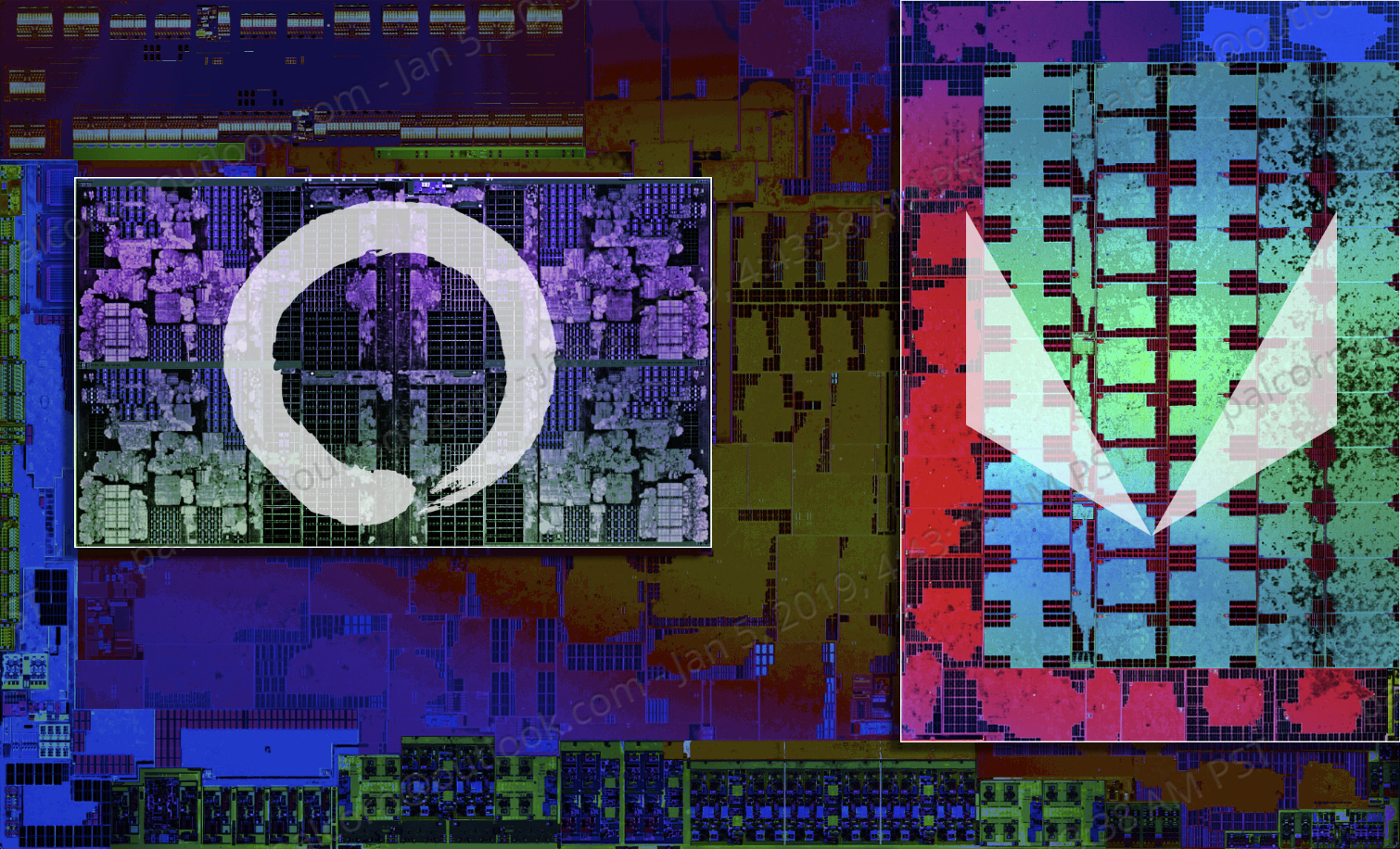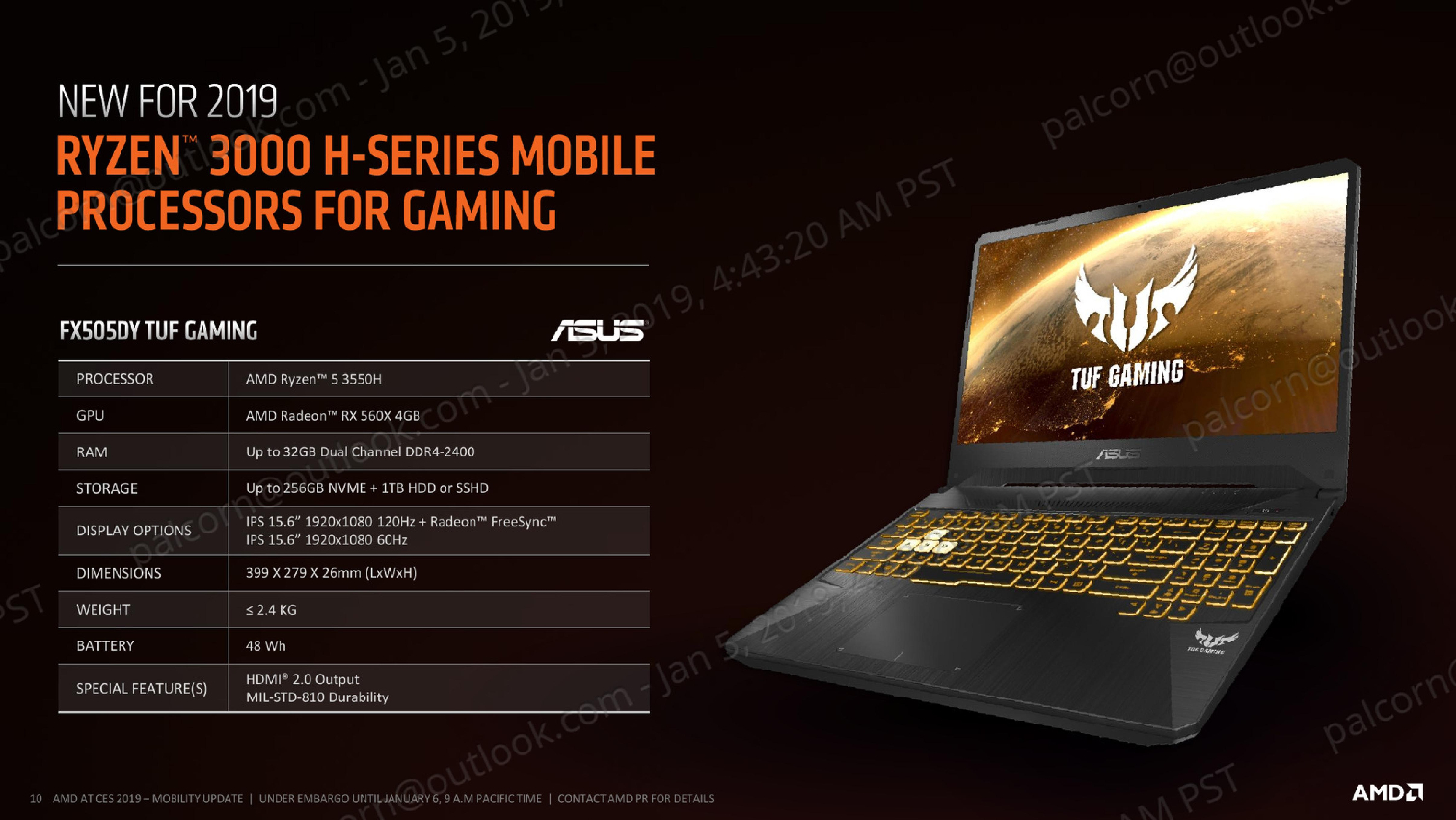AMD Launches 3000-series Picasso APUs, new H-Series and A-Series Processors
As expected, AMD announced a refresh for its mobile lineup with new second-gen Ryzen 3000-series Picasso APUs for the 3, 5, and 7 series. AMD also announced a new Athlon U-Series processor.
AMD has several other new chips, including two new high-performance H-series chips for mainstream gaming laptops, marking AMD's arrival in that key market, and two new Athlon A-Series models that surprisingly tackle the Chromebook segment.
AMD also addressed recent customer complaints about drivers for existing Ryzen Mobile parts, which currently only come from OEMs. Now all Radeon software updates apply to all Ryzen Mobile Laptops, even the previous-gen Ryzen models. That should allow customers to get their bugfixes and day-zero game drivers directly from AMD as they are released.
We fully expect AMD to make further announcements about its progress with its 7nm processors, but that will likely come during Lisa Su's keynote. For now, let's chew over the new chips, but be sure to check back for keynote coverage on January 9 at 9am PT.
Picasso APUs - Ryzen 7, 5, and 3, and a new Athlon for Good Measure
The Ryzen Mobile 3, 5 and 7 processors come armed with Zen+ CPU cores paired with Vega graphics cores in an SoC (System on Chip) design. The chips feature the same basic design as the first-gen Raven Ridge processors, but as we’ve seen with the refreshed Ryzen desktop models, AMD upgraded the cores over the first-gen Zen design. AMD says the the optimized designs offer up to 8% more CPU and GPU performance than their Raven Ridge predecessors.
| Row 0 - Cell 0 | Cores/Threads | TDP | Base / Boost Freq. (GHz) | Graphics | Graphics Base / Boost (MHz) | L3 Cache | Memory | Process | Architecture |
| Ryzen 7 3750H | 4 / 8 | 35W | 2.3 / 4.0 | Radeon Vega 10 | Up to 1,400 | 6MB | DDR4-2400 | 12nm GloFo | Zen+ |
| Ryzen 7 3700U | 4 / 8 | 15W | 2.3 / 4.0 | Radeon Vega 10 | Up to 1,400 | 6MB | DDR4-2400 | 12nm GloFo | Zen+ |
| Ryzen 7 2700U | 4 / 8 | 12 - 25W (15W) | 2.2 / 3.8 | Radeon Vega 10 | Up to 1,300 | 4MB | DDR4-2400 | 14nm GloFo | Zen |
| Ryzen 5 3550H | 4 / 8 | 35W | 2.1 / 3.7 | Radeon Vega 8 | Up to 1,200 | 6MB | DDR4-2400 | 12nm GloFo | Zen+ |
| Ryzen 5 3500U | 4 / 8 | 15W | 2.1 / 3.7 | Radeon Vega 8 | Up to 1,200 | 6MB | DDR-2400 | 12nm GloFo | Zen+ |
| Ryzen 5 2500U | 4 / 8 | 12 - 25W (15W) | 2.0 / 3.6 | Radeon Vega 8 | Up to 1,100 | 4MB | DDR4-2400 | 14nm GloFo | Zen |
| Ryzen 3 3300U | 4 / 4 | 15W | 2.1 / 3.5 | Radeon Vega 8 | Up to 1,200 | 6MB | DDR4-2400 | 12nm GloFo | Zen+ |
| Ryzen 3 2300U | 4 / 4 | 15W | 2 / 3.4 | Radeon Vega 6 | Up to 1,100 | 4MB | DDR4-2400 | 14nm GloFo | Zen |
| Ryzen 3 3200U | 2 / 4 | 15W | 2.6 / 3.5 | Radeon Vega 3 | Up to 1,200 | 5MB | DDR4-2400 | 12nm GloFo | Zen+ |
| Ryzen 3 2200U | 2 / 4 | 15W | 2.5 / 3.4 | Radeon Vega 3 | Up to 1,100 MHz | 4MB | DDR4-2400 | 14nm GloFo | Zen |
| AMD Athlon 300U | 2 / 4 | 15W | 2.4 / 3.3 | Radeon Vega 3 | Up to 1,000 | 5MB | DDR4-2400 | 12nm GloFo | Zen+ |
Zen+ includes more sophisticated multi-core boost algorithms that grant a speedup in everyday desktop use, along with reduced cache and memory latency. AMD also moved from the Global Foundries 14nm node to the 12nm process that provides higher clock speeds within a similar power range, even though it doesn’t confer any density benefits (meaning the transistors still have the same dimensions).
The new process may not be smaller, but optimizations to the design allow for 100 to 200MHz of extra speed for the CPU cores (and an extra 100MHz for the Vega cores) across the breadth of the Picasso stack. As with the last-gen Raven Ridge parts, the Ryzen 7 and 5 models come with four cores and eight threads, while one quad-core Ryzen 3 model comes without threading. The two-pronged Ryzen 3 family also features two dual-core quad-thread parts.
Get Tom's Hardware's best news and in-depth reviews, straight to your inbox.
AMD bumped up the L3 cache to 6MB for the Ryzen 7 and 5 models and split the Ryzen 3 chips between 6MB and 5MB models, based on the core count. As before, the chips also support dual-channel DDR4-2400 memory.
The processors also feature Vega graphics cores that boost from 1,000 MHz with the low-end Athlon 300U up to 1,400 MHz with the flagship Ryzen 7 3750H. AMD also segments based on the number of graphics Compute Units (CU), with models with Radeon Vega 3 graphics featuring 3 CU while Vega 10 equates to 10 CU, and so on.
AMD hasn't said when to expect PIB (Product-In-Box) variants that can be used in typical desktop PCs.

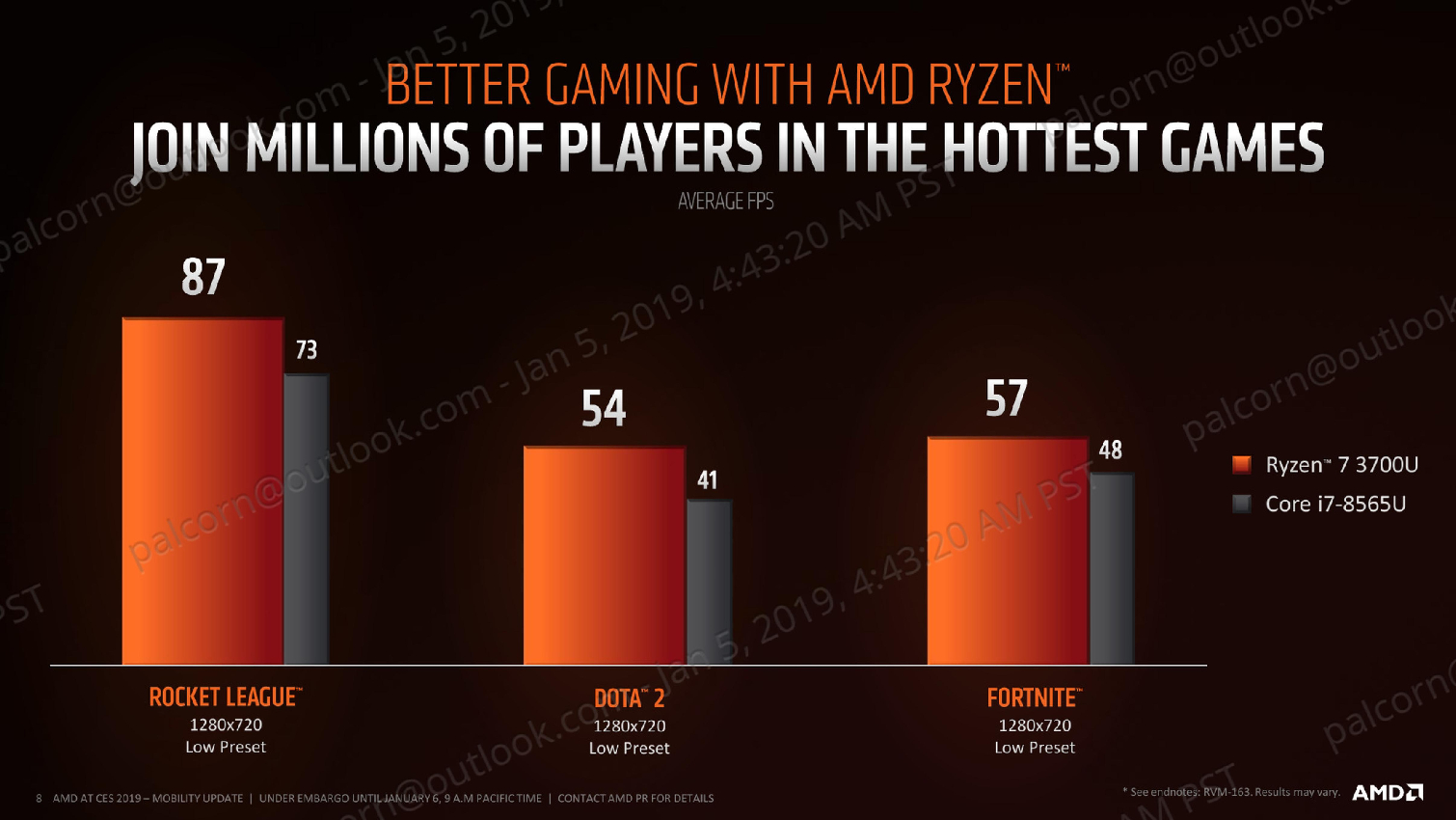
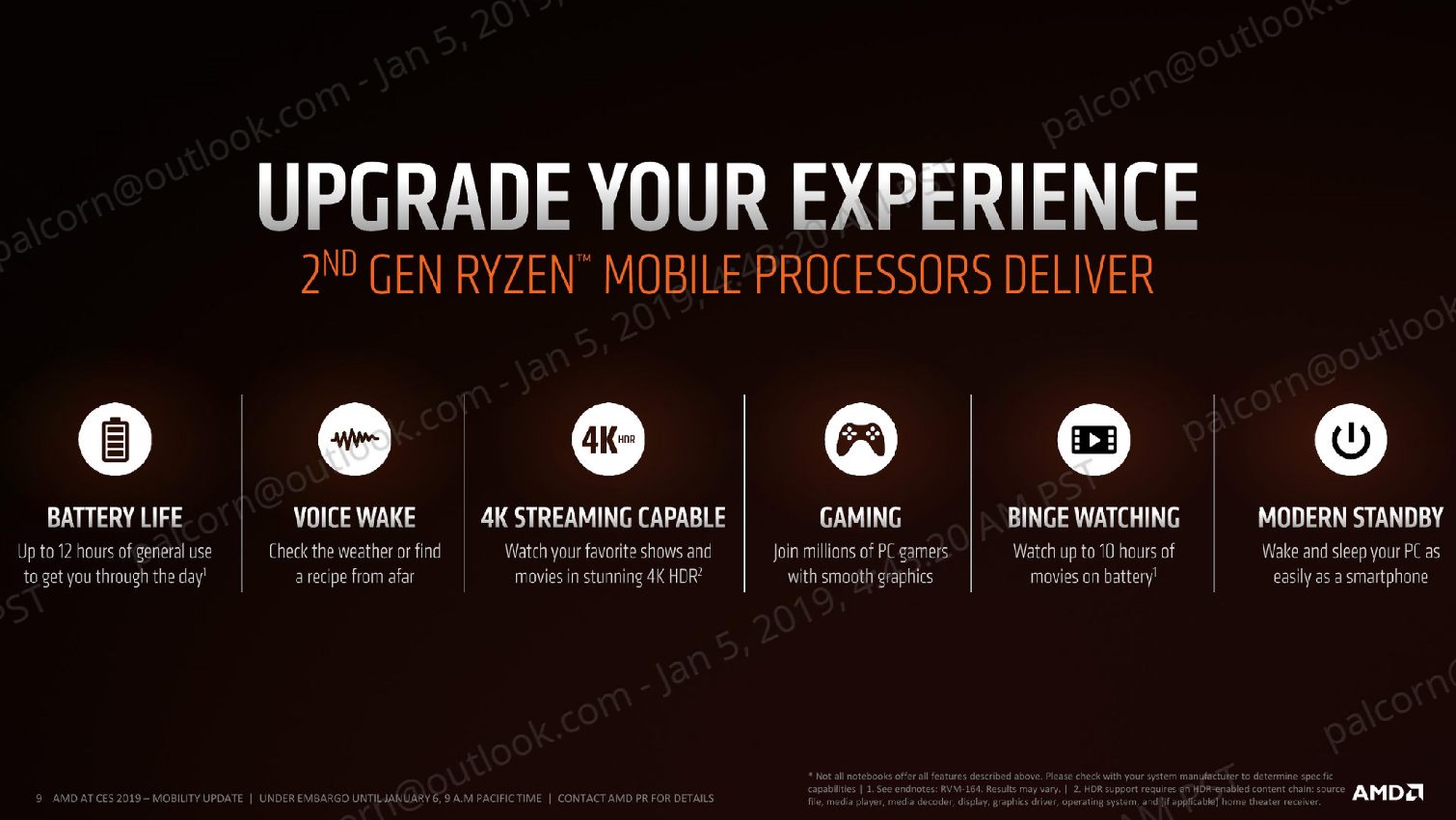
AMD provided its own performance benchmarks that show the new chips comparing well with Intel's Core i5-8250U in office applications and gaming on the integrated graphics. As with any vendor-supplied benchmarks, take these with a grain of salt.
The Ryzen H-Series
AMD’s new Ryzen H-series processors stand out as the most interesting new addition. AMD is testing the waters in the gaming laptop market, so the company dialed the TDP up to 35W for the H-Series processors. Otherwise, the H-series chips are very similar to the U-Series, with the same CPU core counts, 6MB of L3 cache, Vega graphics cores, and even base/boost frequencies.
The higher TDP rating allows the processor to boost more frequently and for longer periods of time. AMD expects OEMs to pair this processor with discrete graphics cards to power mainstream gaming notebooks, so now the fine-grained power delivery system pushes more of the available power budget to the CPU cores instead of the Vega graphics.
AMD also shared specs for one of the first laptops to come to market with the H-Series processor. Unfortunately, many laptops and notebooks with Ryzen processors continue to come with lower-end components, like hard drives instead of SSDs and low- to mid-quality panels, but the ASUS TUF Gaming notebook brings the goods with a Radeon RX560X 4GB paired with a FreeSync-capable IPS panel. You can also select up to 32GB of DDR4-2400 and a 256GB NVMe SSD, making this the kind of platform that AMD has been sorely missing.
Given the H-Series' similar specs to the U-series models, it's easy to conclude that the new H-Series is more of a branding play with the OEMs to convince them to make higher-end notebooks with Ryzen processors than it is a big jump over the U-Series. We'll learn more as the products come to market, but in either case, the H-Series is a welcome addition to the Ryzen Mobile portfolio, especially if it spurs reluctant OEMs to build premium designs. These new designs will come to market in the first quarter of 2019.
Here Come the AMD-powered Chromebooks
| Row 0 - Cell 0 | Cores / Threads | TDP (typ.) | Base / Boost GHz | Radeon Graphics | GPU Cores | GPU Frequency |
| AMD A6-9200C | 2 / 2 | 6W | 1.8 / 2.7 | R5 Series | 3 / 192 (GCN 1.2) | 720 MHz |
| AMD A4-9120C | 2 / 2 | 6W | 1.6 / 2.4 | R4 Series | 3 / 192 (GCN 1.2) | 600 MHz |
AMD is dusting off the older 28nm process and Bristol Ridge architecture to tackle the Chromebook market. The two new A-Series processors don't come wielding the 12nm Zen+ process. Instead, they are an incremental evolution of the existing Carrizo that fields Excavator cores. The Bristol Ridge APUs leverage the 28nm process and Polaris-style GCN (Graphics Core Next) cores, meaning that these chips are built on an aging platform.
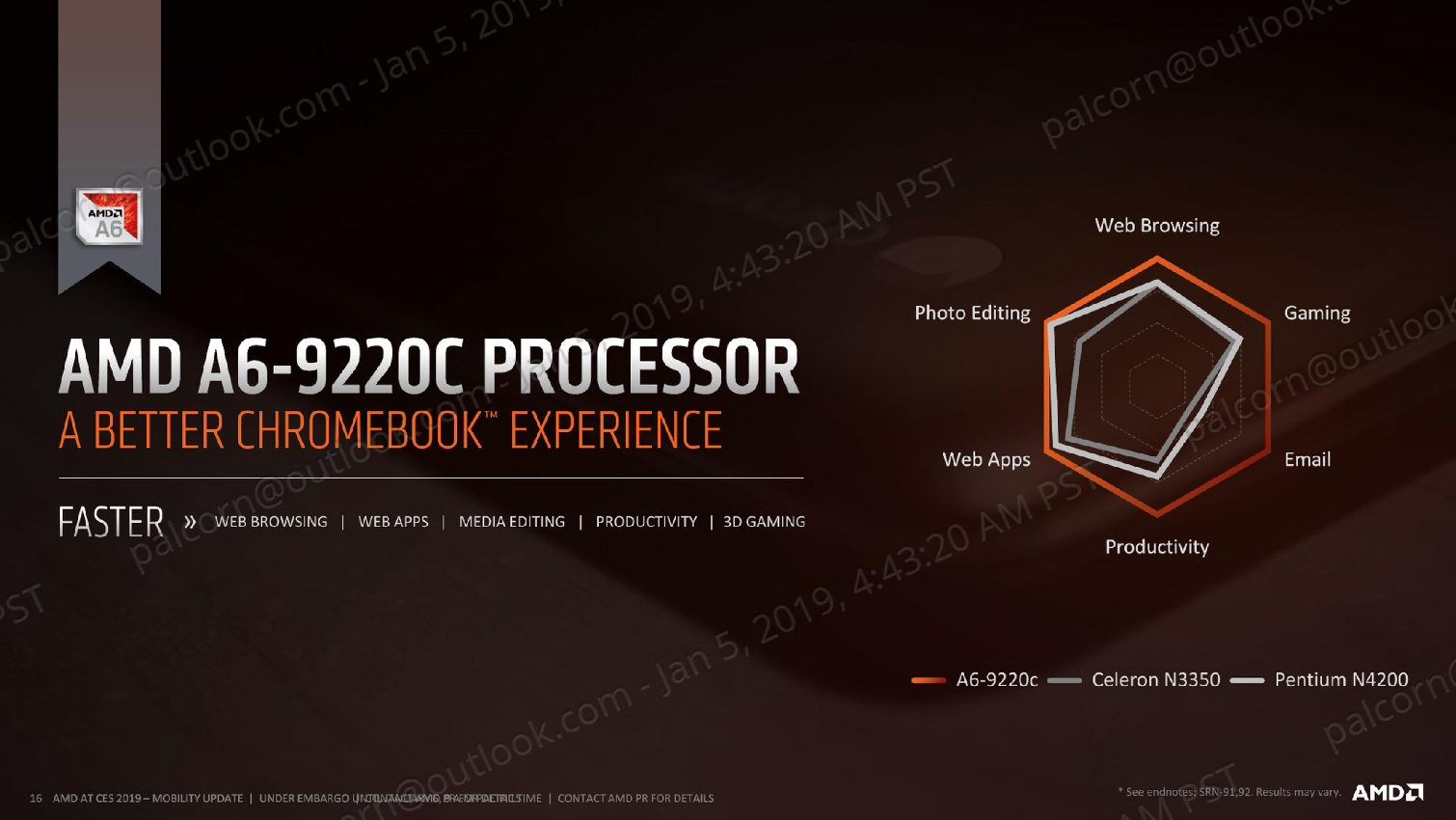
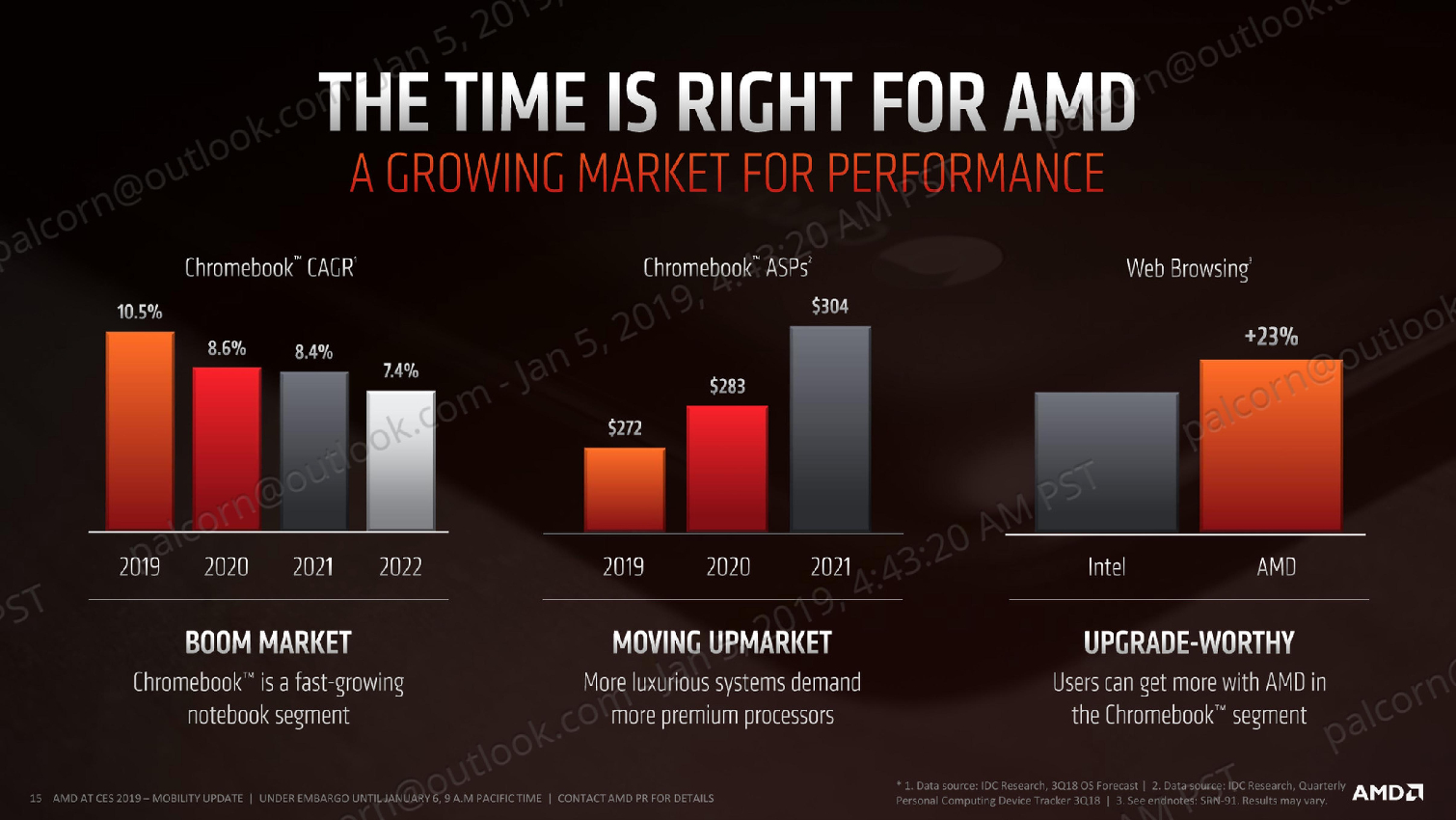
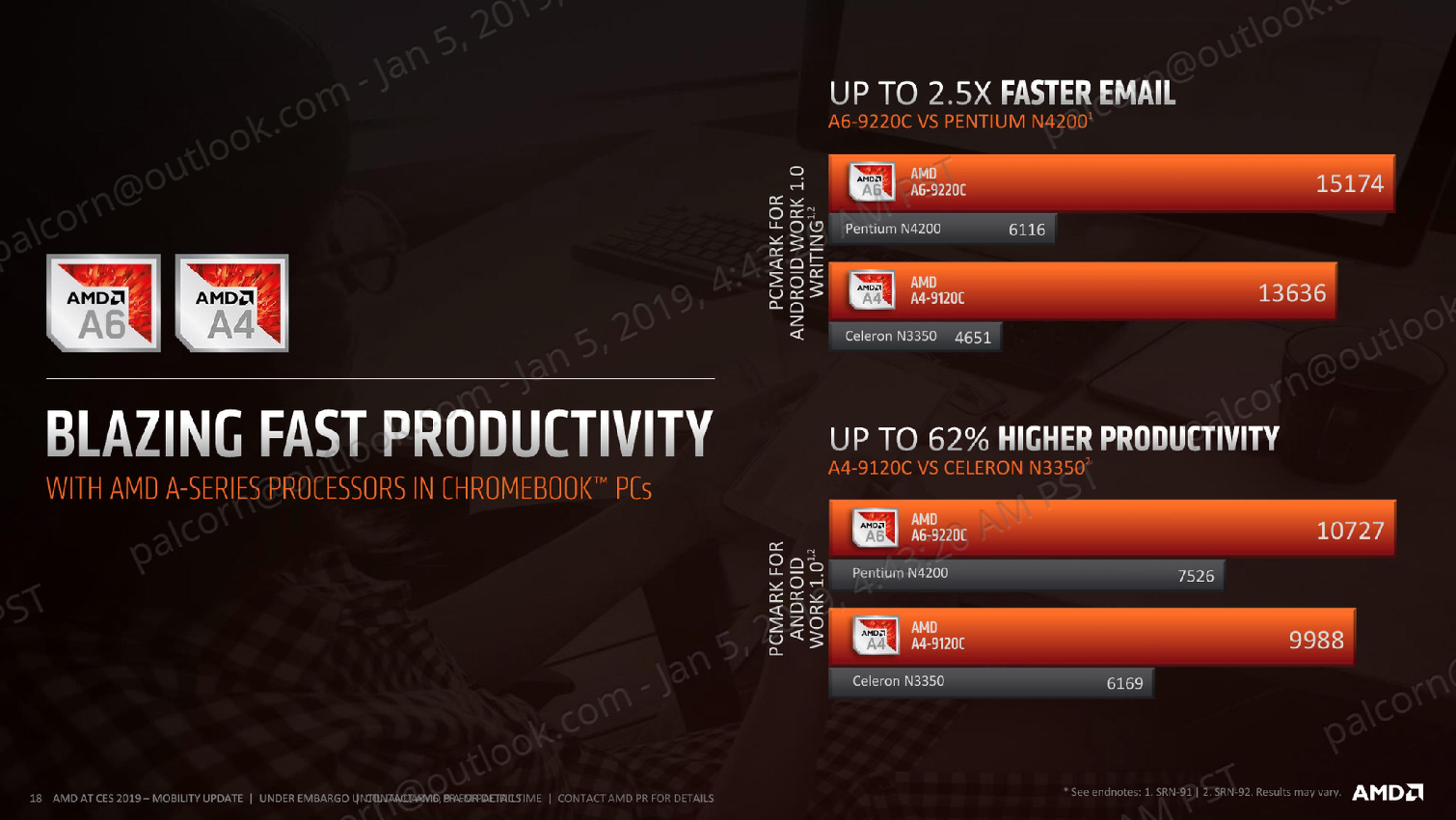
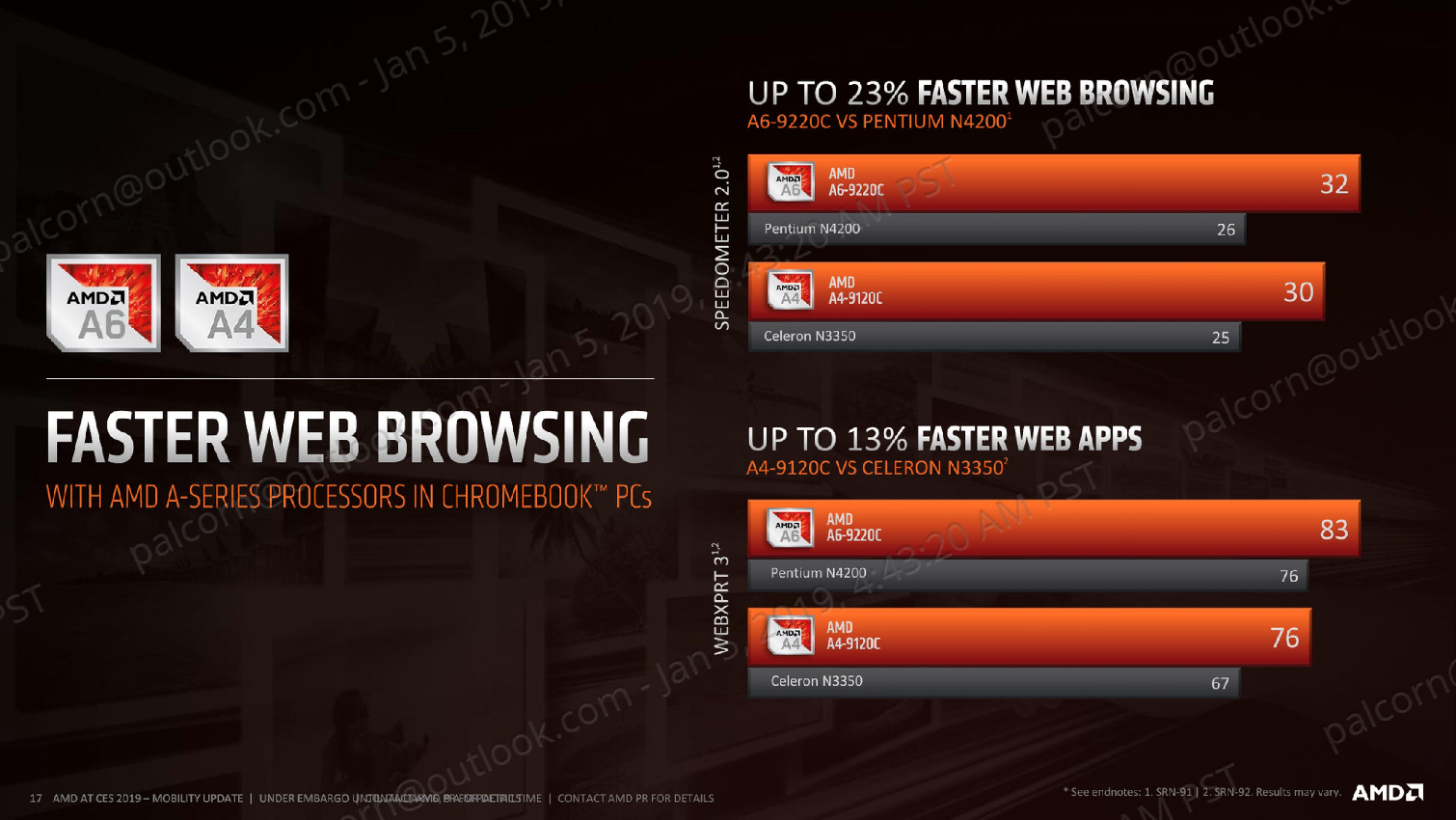
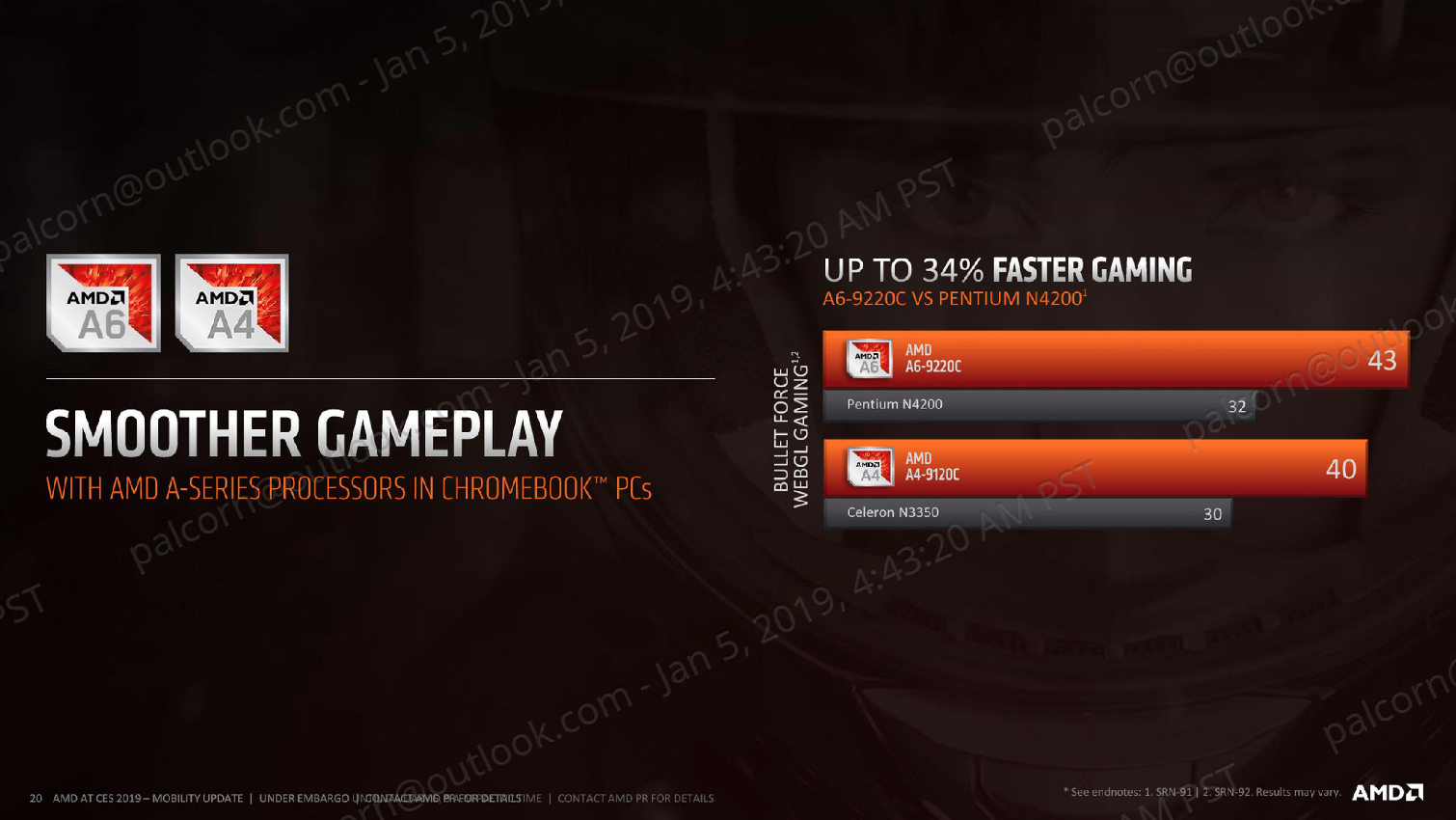
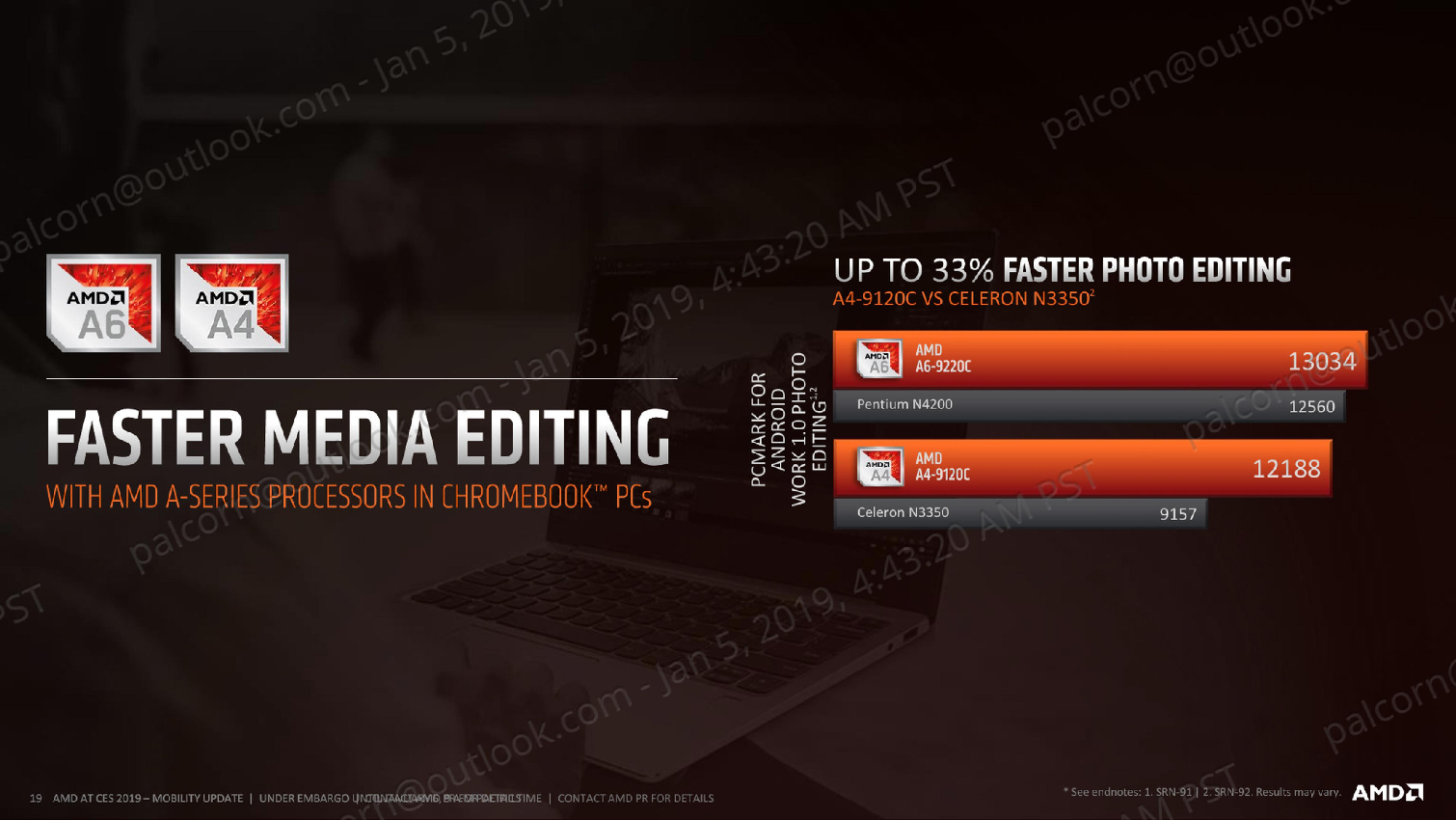
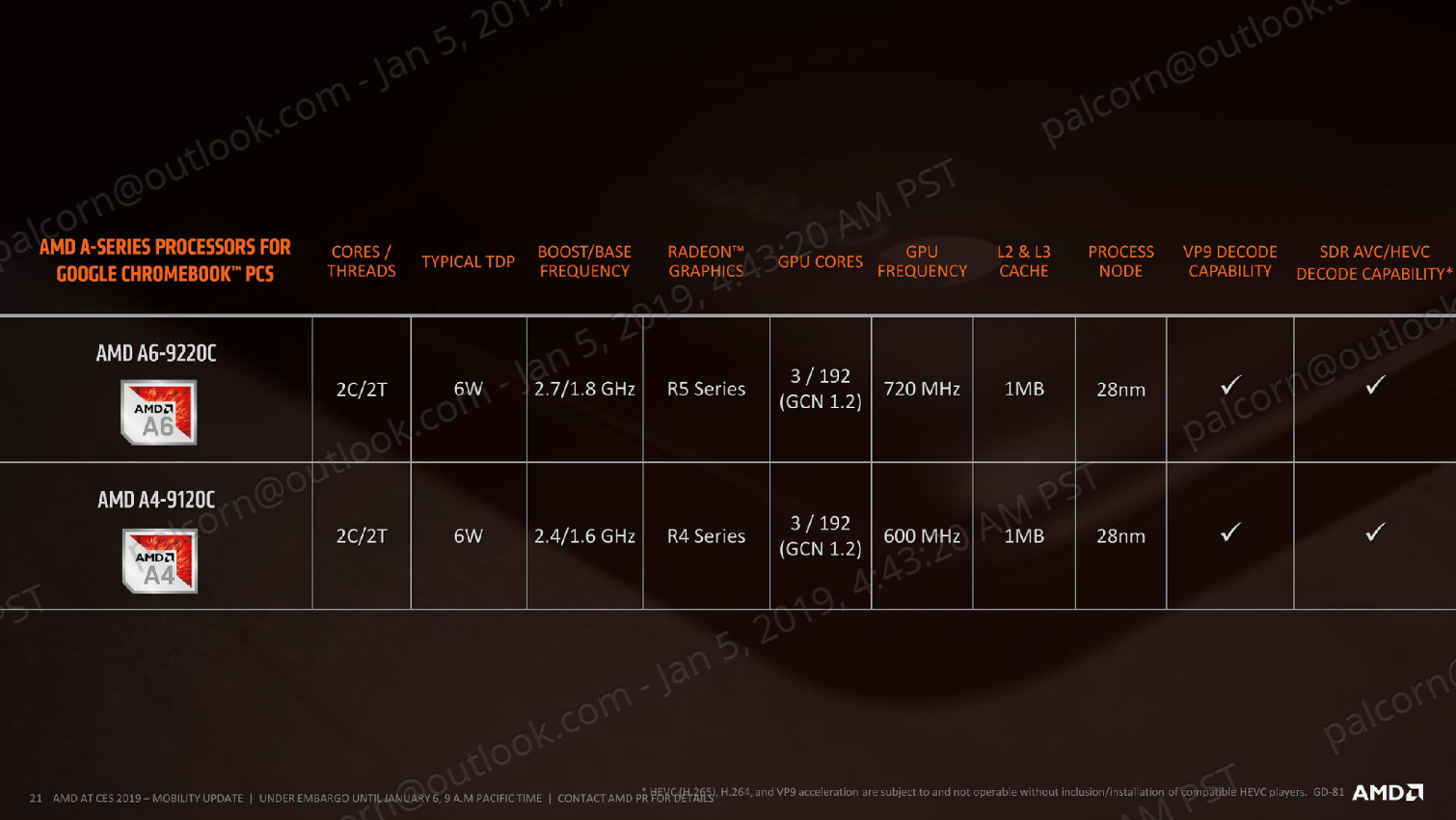
It is surprising, then, that AMD has managed to bring the A-Series down to the 6W threshold and attack the Chromebook segment. The dual-core processors both feature two cores and two threads paired with 3 Radeon R5 or R4 graphics cores. AMD says the new A-Series processors meet the ten-hour battery life requirements for Chromebooks and address a strategic need to extend its product stack further down into the low-power segment to challenge Intel's Pentium and Celeron processors.
The Competitive Landscape
AMD shared slides that show how the shape of the notebook market is changing to more of a focus on Chromebooks, high-end and mainstream devices. AMD says it is targeting the mainstream and premium segments, which represents more sales of high-margin processors. AMD also says that it has 33% more design wins in 2019 with OEMs. Now it also has H-Series processors to attack the high-end and A-Series to attack the low end. That should set the stage for more growth.
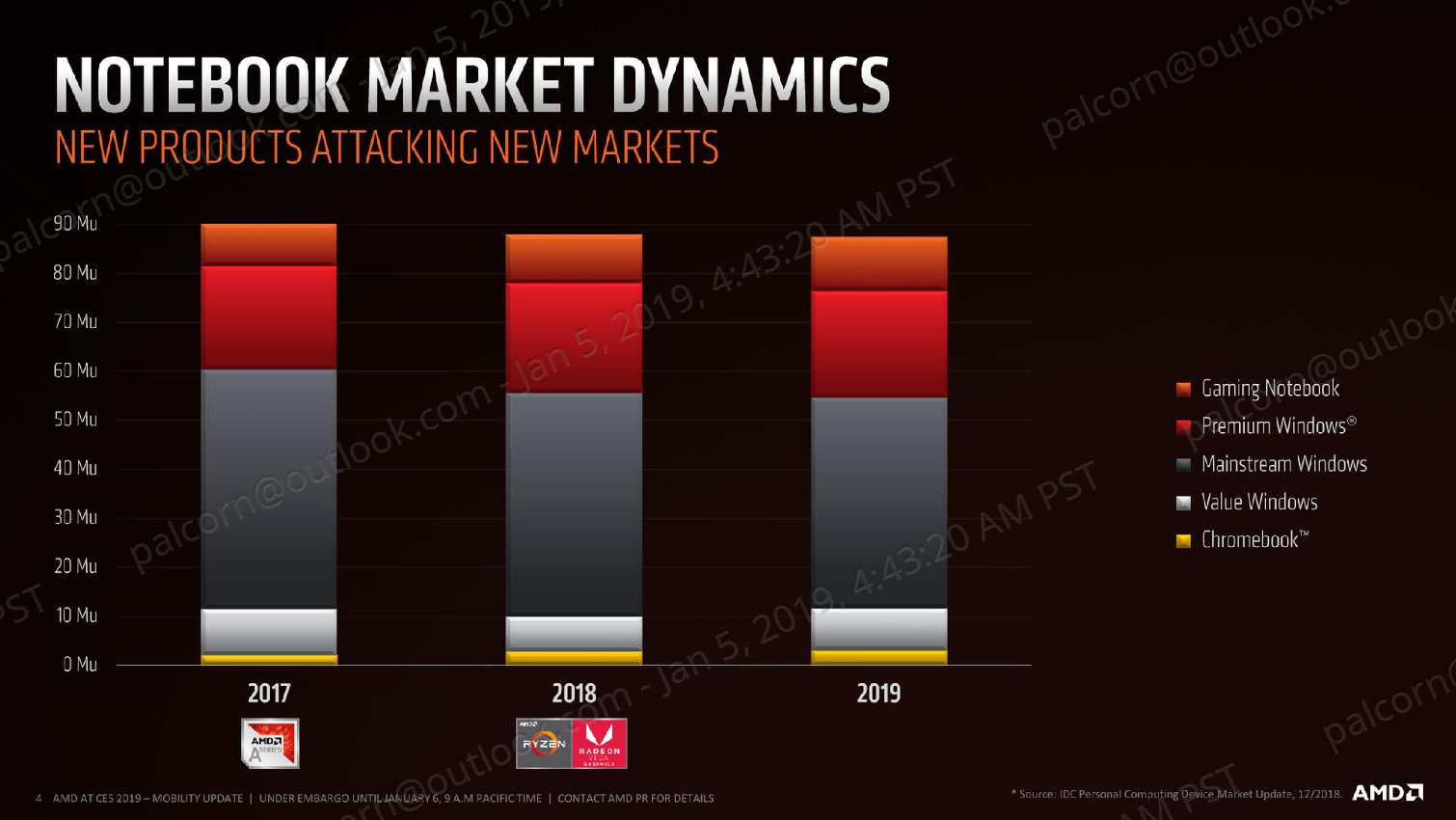
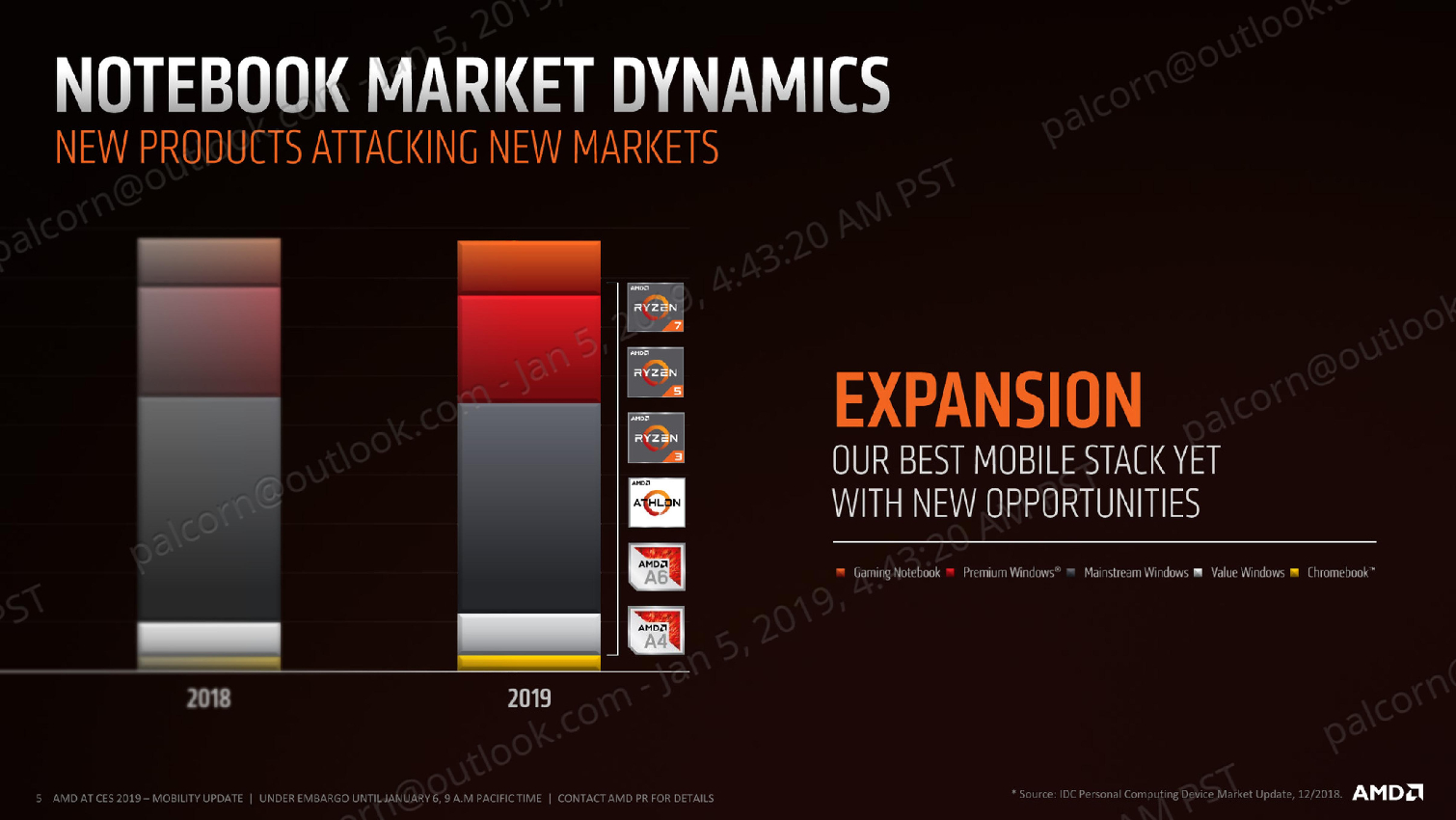
But there are a few caveats. AMD didn’t make any claims of improved battery life with the Picasso APUs, which we would have expected given the benefits of the more efficient manufacturing process. Perhaps AMD chose instead to provide more performance in lieu of improved battery life, but this is an area the company should look to improve.
OEMs have also, maddeningly, continued to bring Ryzen Mobile products to market with low-quality panels and sub-par storage options, among other deficiencies. It appears that AMD’s strategy with the H-Series is to provide some incentive for OEMs to step up their Ryzen notebook game.
And AMD needs a secure beachead in the notebook market, no doubt. The company has gained plenty of ground in the desktop PC market, even expanding Zen down to lower price points with its new Athlon processors, but the notebook segment represents 2/3 of the entire client market, making it strategically important.
Intel says it will have 10nm chips out (in volume) by the end of 2019, and those are largely expected to debut in notebooks. We fully expect AMD’s desktop PC processors to come with the 7nm process at some point this year, giving the company its first process lead over Intel in its history. However, the timing of AMD’s 12nm refresh implies the company won’t bring its 7nm chips to the notebook segment this year, but we know that Intel plans to have notebooks with 10nm processors available for the holidays. That means Intel and AMD will continue to slug it out with their current process nodes for most of the year, provided Intel can keep its processors in stock during its shortage of production capacity.
As for the rest of AMD's anticipated announcements, which will likely come during Lisa Su's keynote, check back for more coverage on January 9 at 9am PT.

Paul Alcorn is the Editor-in-Chief for Tom's Hardware US. He also writes news and reviews on CPUs, storage, and enterprise hardware.
-
compprob237 Those 4 core/8 thread Ryzen APUs should be part of Ryzen 3 or 5 not 7. They should also be 2000 series since they're only Zen1+. :hum:Reply
Oh well. -
joey28boricua Apu's also known as Advanced Processing Units carry a SOC that can handle Graphics and Processing to the Masses the slides we all witness are future reference Chiplets that will be available in 2020 or so , during that segment they will increase core count with these APU'sReply -
salgado18 First gen mobile Ryzen was already model 2000. They screwed up from the beginning, now it's hard to make it right.Reply -
Rogue Leader Its about time regarding the drivers. My HP Envy X360 with Ryzen 5 2500U has been an excellent laptop otherwise marred by ancient drivers. Users have found a hack to make newer drivers work and performance has improved, but its about damn time its officially supported.Reply -
cryoburner Reply
It's common to provide fewer cores on laptop parts, since people are even less likely to be utilizing tons of cores on a notebook computer, and those extra cores would likely just be reducing efficiency in most cases. It might not be as practical to deal with the heat output of significantly more cores on such a device either, at least until their notebook parts make the shift to 7nm. At the very least, it's not nearly as bad as Intel designating some of their low-power dual-core parts as "i7".21650708 said:Those 4 core/8 thread Ryzen APUs should be part of Ryzen 3 or 5 not 7. They should also be 2000 series since they're only Zen1+. :hum:
Oh well.
It is a little odd having both Ryzen 5 and 7 parts with 4-cores and 8-threads, though I guess they consider the differentiating factors here to be clock rates and graphics cores. More odd would be the Ryzen 3 3200U and Athlon 300U, where the differences seem to just come down to moderate differences in clock rates going by the information presented here. Again, this is something that's common on Intel's processors as well though. When it comes to notebook processors, you really need to look at more than just the name to get an idea of what the processor's capabilities are like.
As for the series naming, they likely just want all their 2019 parts to use the same naming conventions, just as all their 2018 parts went under the 2000-series, despite being a mix of 14nm Zen and 12nm Zen+ parts. -
Supahos The first apus for the am4 chipset we're old bulldozer cored chips that didn't carry the 1*** series Branding no idea why they didn't simply fall in line with 1/2/3 series for zen/zen+/zen 2Reply
Guess to confuse the ill informed me -
bigdragon The 3000 series needs to be impressive in hardware, not just on a spec sheet. The problem with the 2000 series was that OEMs put the AMD chips on junk hardware with limited capabilities. 8GB of RAM with a sub-1080, TN panel display and plastic chassis? No. The 3000-series needs to show up in some capable mobile devices to build market share.Reply -
zalazin Well so far AMD haS DONE no real support but promise now a year and four months later AMD drivers for the R2500u w Vega 8? I'll believe it when it happens. Amd has lost me forever Intel and Nvidia from now on...PLus my neverending condemnation of HP and AMD..Reply
